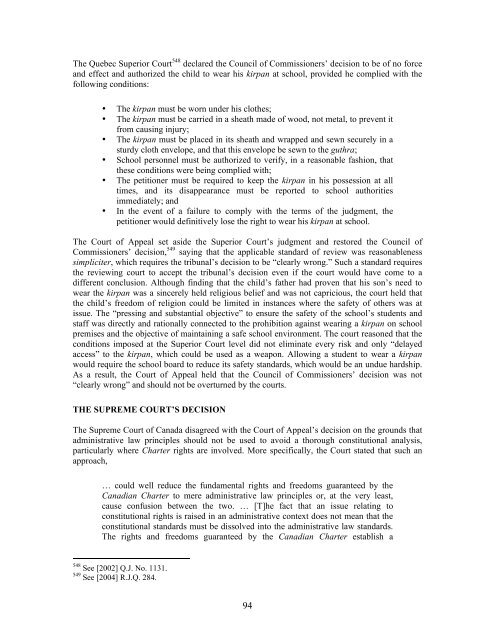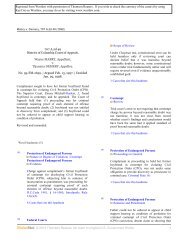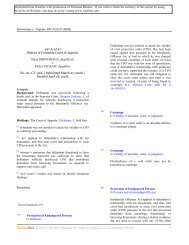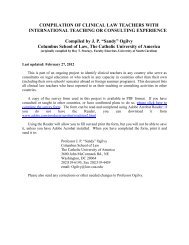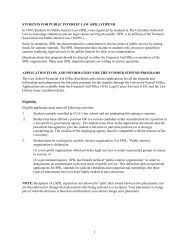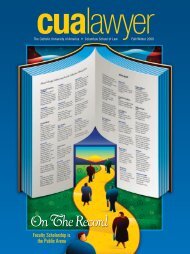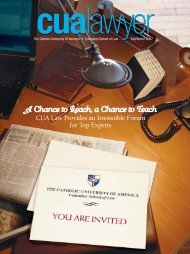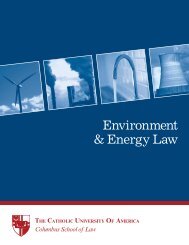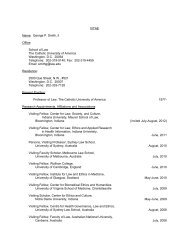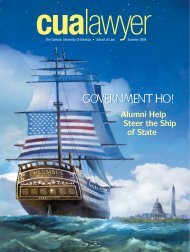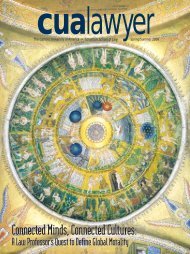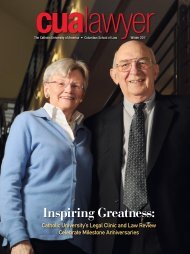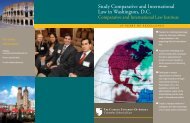The Quebec Superior Court 548 declared the Council <strong>of</strong> Commissioners’ decision to be <strong>of</strong> no forceand effect and authorized the child to wear his kirpan at school, provided he complied with thefollowing conditions:• The kirpan must be worn under his clothes;• The kirpan must be carried in a sheath made <strong>of</strong> wood, not metal, to prevent itfrom causing injury;• The kirpan must be placed in its sheath and wrapped and sewn securely in asturdy cloth envelope, and that this envelope be sewn to the guthra;• <strong>School</strong> personnel must be authorized to verify, in a reasonable fashion, thatthese conditions were being complied with;• The petitioner must be required to keep the kirpan in his possession at alltimes, and its disappearance must be reported to school authoritiesimmediately; and• In the event <strong>of</strong> a failure to comply with the terms <strong>of</strong> the judgment, thepetitioner would definitively lose the right to wear his kirpan at school.The Court <strong>of</strong> Appeal set aside the Superior Court’s judgment and restored the Council <strong>of</strong>Commissioners’ decision, 549 saying that the applicable standard <strong>of</strong> review was reasonablenesssimpliciter, which requires the tribunal’s decision to be “clearly wrong.” Such a standard requiresthe reviewing court to accept the tribunal’s decision even if the court would have come to adifferent conclusion. Although finding that the child’s father had proven that his son’s need towear the kirpan was a sincerely held religious belief and was not capricious, the court held thatthe child’s freedom <strong>of</strong> religion could be limited in instances where the safety <strong>of</strong> others was atissue. The “pressing and substantial objective” to ensure the safety <strong>of</strong> the school’s students andstaff was directly and rationally connected to the prohibition against wearing a kirpan on schoolpremises and the objective <strong>of</strong> maintaining a safe school environment. The court reasoned that theconditions imposed at the Superior Court level did not eliminate every risk and only “delayedaccess” to the kirpan, which could be used as a weapon. Allowing a student to wear a kirpanwould require the school board to reduce its safety standards, which would be an undue hardship.As a result, the Court <strong>of</strong> Appeal held that the Council <strong>of</strong> Commissioners’ decision was not“clearly wrong” and should not be overturned by the courts.THE SUPREME COURT’S DECISIONThe Supreme Court <strong>of</strong> Canada disagreed with the Court <strong>of</strong> Appeal’s decision on the grounds thatadministrative law principles should not be used to avoid a thorough constitutional analysis,particularly where Charter rights are involved. More specifically, the Court stated that such anapproach,… could well reduce the fundamental rights and freedoms guaranteed by theCanadian Charter to mere administrative law principles or, at the very least,cause confusion between the two. … [T]he fact that an issue relating toconstitutional rights is raised in an administrative context does not mean that theconstitutional standards must be dissolved into the administrative law standards.The rights and freedoms guaranteed by the Canadian Charter establish a548 See [2002] Q.J. No. 1131.549 See [2004] R.J.Q. 284.94
minimum constitutional protection that must be taken into account by thelegislature and by every person or body subject to the Canadian Charter. 550Since this complaint was based entirely on the issue <strong>of</strong> freedom <strong>of</strong> religion, the Court determinedthat the administrative law standard <strong>of</strong> review was not relevant. In other words, the child’s fatherwas not challenging the Council <strong>of</strong> Commissioners’ jurisdiction to approve the code <strong>of</strong> conduct,or the administrative or constitutional validity <strong>of</strong> the rule against carrying weapons and dangerousobjects. Rather, the concern was that the refusal to agree to a reasonable accommodation violatedhis son’s freedom <strong>of</strong> religion. The Court concluded that “it is the constitutionality <strong>of</strong> the decisionthat is in issue in this appeal, which means that a constitutional analysis must be conducted.” 551Following precedent, this required that the decision be subjected to the test set out in section 1 <strong>of</strong>the Charter. 552Was There a Charter Infringement?The Court found that the Council <strong>of</strong> Commissioners’ decision clearly infringed the student’sfreedom <strong>of</strong> religion. In this respect, the Court reviewed previous decisions on the issue, approvingthe key principles, such as:The essence <strong>of</strong> the concept <strong>of</strong> freedom <strong>of</strong> religion is:o the right to entertain such religious beliefs as a person chooses;o the right to declare religious beliefs openly and without fear <strong>of</strong> hindranceor reprisal; ando the right to manifest religious belief by worship and practice or byteaching and dissemination; 553No one is to be forced to act in a way contrary to his or her beliefs orconscience, subject to such limitations as are necessary to protect publicsafety, order, health, or morals or the fundamental rights and freedoms <strong>of</strong>others; 554It is not for the state to dictate what are the religious obligations <strong>of</strong> theindividual, it is for the individual to determine; 555Freedom <strong>of</strong> religion consists <strong>of</strong>:o the freedom to undertake practices and harbour beliefs, having a nexuswith religion, in which an individual demonstrates he or she sincerelybelieves or is sincerely undertaking in order to connect with the divine oras a function <strong>of</strong> his or her spiritual faitho this is irrespective <strong>of</strong> whether a particular practice or belief is required by<strong>of</strong>ficial religious dogma or is in conformity with the position <strong>of</strong> religious<strong>of</strong>ficials; 556In order to establish that a claimant’s freedom <strong>of</strong> religion has been infringed,it must be shown that the claimant sincerely believes in a practice or belief550 Multani, supra note 545 at para. 16 [emphasis in original].551 Ibid. at para. 21 [emphasis in original].552 Slaight Communications Inc. v. Davidson, [1989] 1 S.C.R. 1308.553 R. v. Big M Drug Mart Ltd., [1985] 1 S.C.R. 295 (“Big M. Drug”).554 Ibid.555 Ibid.556 Syndicat Northcrest v. Amselem, [2004] 2 S.C.R. 551 (“Amselem”). For more discussion <strong>of</strong> the Amselemdecision, see e.g. Terrance S. Carter, “Supreme Court <strong>of</strong> Canada Adopts Broad View <strong>of</strong> ReligiousFreedom” in Church <strong>Law</strong> Bulletin No. 5 (23 August 2004), available at www.churchlaw.ca.95
- Page 1 and 2:
INTERNATIONAL JOURNAL OF CIVIL SOCI
- Page 3 and 4:
Letter from the EditorDear Readers,
- Page 5 and 6:
TABLE OF CONTENTSIJCSL EDITORIAL BO
- Page 7 and 8:
ARTICLESTHE ROLE OF THE ISLAMIC WAQ
- Page 9 and 10:
‘a bewildering array of the good,
- Page 11 and 12:
[a]lthough civil society organizati
- Page 13 and 14:
to integrate economic development a
- Page 15 and 16:
duty.’ 55 In contrast to zakāt,
- Page 17 and 18:
of such venerable educational insti
- Page 19 and 20:
avoiding the appearance of impiety,
- Page 21 and 22:
…’ 101 Throughout the Islamic w
- Page 23 and 24:
partisan judiciary, a vigilant pres
- Page 25 and 26:
number of awqaf for myriad public p
- Page 27 and 28:
made over to the plundering hands o
- Page 29 and 30:
prescribed by law. 159 Like the 192
- Page 31 and 32:
property is not a waqf property or
- Page 33 and 34:
VIII. REFERENCESA. Articles/BooksAh
- Page 35 and 36:
Meidinger, Errol E, ‘Environmenta
- Page 37 and 38:
STUDENT ARTICLESINTERNATIONAL INSTR
- Page 39 and 40:
interest for the Balkan, minorities
- Page 41 and 42:
dimension is emphasized with Articl
- Page 43 and 44: The Copenhagen document deals with
- Page 45 and 46: Historically, the 1946 Constitution
- Page 47 and 48: service, or sometimes 239 special f
- Page 49 and 50: This position by the Greek governme
- Page 51 and 52: a member of the civil state, entitl
- Page 53 and 54: Civilization" with headquarters in
- Page 55 and 56: term "vinozhito"(rainbow) could pos
- Page 57 and 58: declare the party as unconstitution
- Page 59 and 60: The cases analyzed below, exemplify
- Page 61 and 62: ECHR, and based upon this analysis,
- Page 63 and 64: Jabuka in particular, recognized as
- Page 65 and 66: the minority still face problems in
- Page 67 and 68: BibliographyBooks:BLACK’S LAW DIC
- Page 69 and 70: Vlassis Vlassidis, Veniamin Karakos
- Page 71 and 72: THE DIFFERING TAX TREATMENT OF INVE
- Page 73 and 74: …any person who, for compensation
- Page 75 and 76: the assets under management. 437 Th
- Page 77 and 78: As a preliminary matter, a taxpayer
- Page 79 and 80: Commissioner further summarized the
- Page 81 and 82: number of itemized returns. These t
- Page 83 and 84: fiduciary duty implications applica
- Page 85 and 86: operate as a fraud or deceit upon t
- Page 87 and 88: Policy ConsiderationsIn light of th
- Page 89 and 90: more advantageous to address altern
- Page 91 and 92: STUDENT NOTESBUILDING CONSUMER CAPA
- Page 93: CASE NOTESC A N A D I A N S U P R E
- Page 97 and 98: objective of ensuring safety in sch
- Page 99 and 100: Turning to its impact on courts and
- Page 101: tribunals to ensure that an appropr


